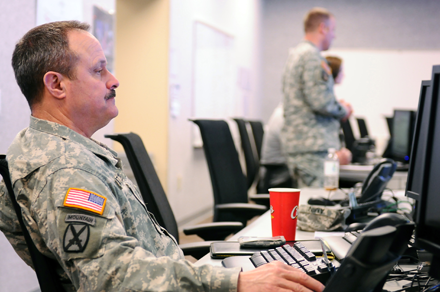 |
Chief Warrant Officer 3 Paul Pitzer, a member of Joint Force Headquarters-Ohio, works at a computer terminal in the Ohio National Guard Joint Operations Center in Columbus, Ohio, which was completed in early January 2012. (Ohio National Guard photo by Capt. Matt Molinski) |
COLUMBUS, Ohio (March 15, 2012) — The Ohio National Guard recently tested the validity of its mission statement, “when called, we respond with ready units to execute federal, state and community missions,” as a pandemic flu outbreak erupted on an international scale, and many Ohioans tragically fell victim to the virus.
Fortunately, for the ONG Joint Force Headquarters staff, the outbreak was notional, actually an Emergency Management Staff Trainer (EMST) exercise supported by employees from two government contracting companies — Engineering & Computer Simulations and Critical Ops. The team proctored the EMST exercise for ONG's JFHQ based on a worldwide pandemic flu outbreak. During the computer-based four-hour training event in January, more than 20 JFHQ staff members tested their capability to work collectively to mobilize the ONG across the state to deal with the pandemic, in support of civilian first responders.
The EMST (www.train-emst.com) was created in early 2001 to establish a common exercising platform, among varied civilian and military entities, for emergency situations. As a web-based interface, there is no software installation requirement for the user. Players simply login and begin the exercise as an individual, a staff section or at a collective level.
“The whole design was to make it easy for anyone involved in emergency to use, and we are always adapting the system, based on user feedback,” said Chelsea Treboniak, owner of Critical Ops.
The customizable scenarios provide an increased level of realism, through time and information constraints that force players to test their decision making process. The pandemic flu is one of 11 base scenarios currently offered within EMST.
“We will progressively expand the scope of the exercise into multi-shift, multi-day operations,” said Col. Scott White, Ohio National Guard deputy chief of the joint staff for operations, who immediately began coordination for another EMST training event this August. White also plans to customize the chosen EMST training scenario to meet the needs of the ONG JFHQ staff.
At the national level, Maj. Bill Brohard, EMST program manager at National Guard Bureau, is helping states participate in EMST scenarios, and believes the relative low cost is only one of many benefits to states.
“Training for the EMST is built into the program so it's self contained. The system is also available 24 hours a day, seven days a week, so you can use it anytime,” Brohard said. “Because the system is web-based, other agencies outside of the military can participate too.”
At the completion of an exercise, the EMST automatically produces an after action review for each individual player. The AAR identifies each significant part of the overall scenario and how the player responded to it. This provides facilitators the ability to assess a player's training proficiency in relation to their assigned tasks from the Joint Mission Essential Task List. The JMETL is outlined in the Joint Training Information Management System (www.jtimsguide.us) and feeds the Defense Readiness Reporting System, where units can measure their readiness to execute particular tasks.
During the January EMST exercise, Ohio became the first state to train directly with their JTIMS training objectives and upload their AAR results into JTIMS/DRRS. The process of training, evaluation and assessing through the JTIMS/DRRS model is redeveloping the way military organizations measure readiness.
“EMST exercises encompass the way the JMETL training cycle is supposed to work,” Treboniak said.
In addition to assessing the staff's capabilities, Ohio had the opportunity to exercise its recently constructed joint operations center, located at Beightler Armory in Columbus. The importance of running these exercises is more than just measuring readiness, statistically — it's also about assessing if a staff can perform in the case of an actual event, like the pandemic flu.
“We will be either conducting another exercise or have a real-world event that will test the same aspects that EMST did,” said Col. Chip Tansill, Ohio National Guard chief of the joint staff. |